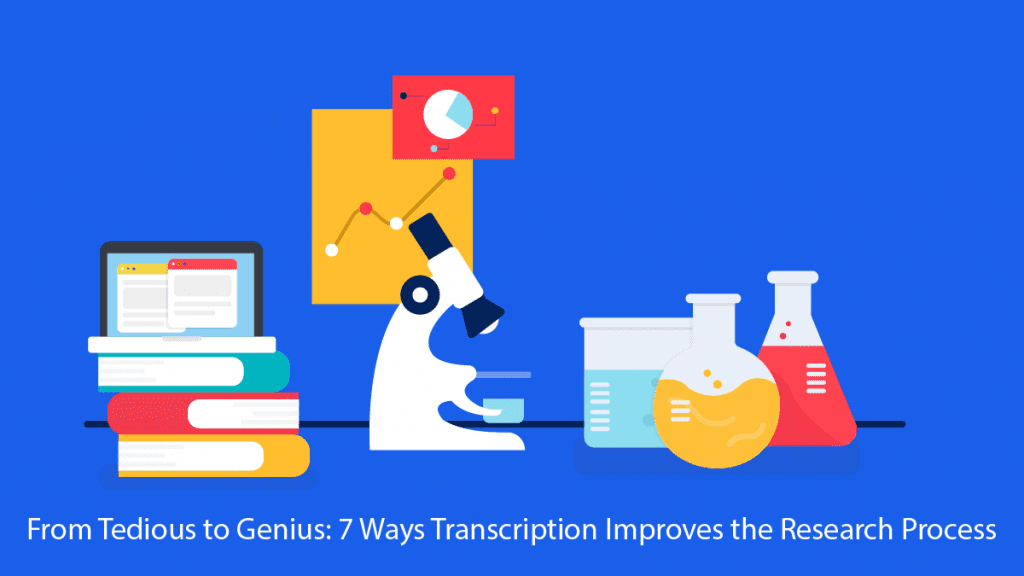From Tedious to Genius: 7 Ways Transcription Improves the Research Process
Transcription is a tedious but necessary part of research work, especially if you want to ensure accuracy and avoid missing important details. Here are some benefits of using transcription in the research process.

Do you work on research that involves extensive interviews and notetaking?
If you do, or ever have, then you understand that it’s important to maintain the integrity of the research source material by transcribing it accurately. You also know that the real challenge comes when compiling hours upon hours of interview analysis into a coherent finished product.
When doing it all yourself, you might actually spend more time trying to transcribe what was recorded than putting actual thoughts and insights into your report. A two-hour focus group recording can easily take more than eight hours to transcribe. For data analysts that can really slow up the process.

Still, transcription is a tedious but necessary part of research work, especially if you want to ensure accuracy and avoid missing important details. The good news is that thanks to today’s gig economy, it’s simple and more affordable than ever to hire a pro to do this work for you.
New to transcription services? Here are some questions you can ask to make sure you’re choosing the best service for your research needs.
Researchers no longer have to toil away for hours listening, typing, rewinding, and typing some more. Using a professional transcription service can improve your entire research process in ways you may not have even considered.
Here are some benefits of using transcription in the research process.
1. Capture every detail, and stay engaged
Ever try to take notes while staying engaged in conversation? It’s not easy to do. And if the subject is a fast talker or several people are being interviewed together, it’s almost impossible to keep up.
Put the burden of capturing all the details on a portable recorder or recording app. Afterall, that’s what they were made for.
As an interviewer, your time is best spent listening and asking thoughtful follow-up questions. If you’re going to take notes, don’t worry about capturing every word. Instead, notate the time stamp on the recorder when a particularly strong quote was spoken.
Having the peace of mind that your interview is being recorded eliminates pressure so you can stay engaged with what the interviewee is saying. It also frees you up to make observations that you might not have noticed if you were too busy scribbling notes.
2. Spend time on the tasks you do best
Transcription services have a cost, but so does your time. Researchers spend a significant amount of time finding the right subjects, preparing questions and collecting qualitative data. Why spend additional time on tedious typing work when someone else could handle it for you?
Outsourcing transcription work frees up time for you to spend on additional research and data analysis. With a reliable transcription service, you can have your audio files converted to text in less than 24 hours while you focus on more pressing work that can’t be handed off to someone else.
3. Make content instantly actionable
When it comes to quantitative data, researchers can immediately take action once they have the numbers. That’s not the case with qualitative data. There’s a significant amount of work a researcher must do before analyzing qualitative research — mostly transcription work. Transcripts lay all of the qualitative data out in one place, making it easier for researchers to pull quotes, identify patterns, and spot anomalies.
4. Easily share research findings with others
Analyzing content directly from audio or video recordings might be feasible for a research team of one. But, how often does a researcher work completely alone?
If others are reviewing your work or offering guidance, transcripts are easy to share and make research content accessible to everyone. Using Rev’s collaborative transcript features, researchers and their colleagues will be able to fully participate and lend thorough insights to a project.
Listen to audio. Read. Edit. Highlight. All changes are auto-saved in one place.

Share transcripts by email or link for others to listen to audio, edit, and highlight the transcript too.


5. Use searchable text to find exactly what you’re looking for
Oftentimes, research takes place over a long stretch of time. It can be difficult to remember who said what or when a particular conversation took place. Imagine having to listen through months of audio files to try to locate that golden nugget of information.
Transcripts, however, are searchable. Once a lengthy audio file is transcribed, a quick keyword search will help you locate the clips you need in seconds. This can be done using the quick find/search command on your keyboard. To search the contents of a document, use Command + F on Mac or Ctrl + F on a PC.
6. Revisit a conversation
Since tone is not captured, the written text doesn’t always provide the context of what someone was trying to say. Having your research transcribed makes it easier to fact check audio clips later.
Transcribed files that indicate speaker names and provide timestamps are especially useful. That way, when you do have to go back into the original audio, it will be easy to cue up the exact moment you need to reference.
7. Take a more objective view
If you’re taking and relying on your own notes, it’s only human nature that you might inadvertently omit part of what’s being said, or perhaps you might add your own interpretation. Transcription ensures that nothing is left to chance, and you’ll have a word-for-word account of the conversation in front of you.
The takeaway for researchers
Audio recordings are an important part of the research, but it’s easy for the content to get lost in translation if you don’t have a verbatim transcript to work from. Investing in a transcription service can not only make your life easier, but it can help ensure that your work is perceived as credible.
Heading
Heading 1
Heading 2
Heading 3
Heading 4
Heading 5
Heading 6
Lorem ipsum dolor sit amet, consectetur adipiscing elit, sed do eiusmod tempor incididunt ut labore et dolore magna aliqua. Ut enim ad minim veniam, quis nostrud exercitation ullamco laboris nisi ut aliquip ex ea commodo consequat. Duis aute irure dolor in reprehenderit in voluptate velit esse cillum dolore eu fugiat nulla pariatur.
Block quote
Ordered list
- Item 1
- Item 2
- Item 3
Unordered list
- Item A
- Item B
- Item C
Bold text
Emphasis
Superscript
Subscript

Subscribe to The Rev Blog
Sign up to get Rev content delivered straight to your inbox.



